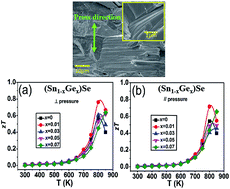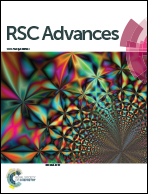The effects of Ge doping on the thermoelectric performance of p-type polycrystalline SnSe†
Abstract
Recently single crystal SnSe has attracted much attention due to its unprecedented high zT (∼2.6) value, which has stimulated curiosity to study its polycrystalline counterparts by effective doping. Polycrystalline (Sn1−xGex)Se specimens were prepared by melting and spark plasma sintering (SPS) to improve the thermoelectric performance and mechanical properties of pristine SnSe. This study systematically investigated the Ge doping effects and discussed the anisotropic behavior on the thermoelectric (TE) properties of SPS sintered (Sn1−xGex)Se samples. We found that Ge doping not only results in a remarkable enhancement of Seebeck coefficient but also reduces the thermal conductivity of the (Sn1−xGex)Se series. All Ge-doped compounds show a low thermal conductivity, which is mainly attributed to phonon scattering from disordered dopant atoms and the high anharmonic bonding nature of SnSe. This led to a maximum zT of 0.77, which was obtained at 800 K for (Sn0.99Ge0.01)Se, which shows an approximately 40% enhancement over the pristine polycrystalline SnSe (zT = 0.56). Consequently, (Sn1−xGex)Se is a promising candidate for highly efficient thermoelectric materials.


 Please wait while we load your content...
Please wait while we load your content...